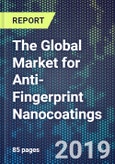1 Introduction
1.1 Aims and objectives of the study
1.2 Market definition
1.2.1 Properties of nanomaterials
1.2.2 Categorization
3 Executive summary
3.1 High performance coatings
3.2 Nanocoatings
3.3 Market drivers and trends
3.4 Global market size and opportunity to 2030
3.4.1 End user market for nanocoatings
3.4.2 Global revenues for nanocoatings 2010-2030
3.4.3 Global revenues for nanocoatings, by market
3.4.3.1 The market in 2017
3.4.3.2 The market in 2018
3.4.3.3 The market in 2030
3.4.4 Global revenues by nanocoatings, by type
3.4.5 Regional demand for nanocoatings
3.5 Market and technical challenges
4 Nanocoatings technical analysis
4.1 Properties of nanocoatings
4.2 Benefits of using nanocoatings
4.2.1 Types of nanocoatings
4.3 Production and synthesis methods
4.3.1 Film coatings techniques analysis
4.3.2 Superhydrophobic coatings on substrates
4.3.3 Electrospray and electrospinning
4.3.4 Chemical and electrochemical deposition
4.3.4.1 Chemical vapor deposition (CVD)
4.3.4.2 Physical vapor deposition (PVD)
4.3.4.3 Atomic layer deposition (ALD)
4.3.4.4 Aerosol coating
4.3.4.5 Layer-by-layer Self-assembly (LBL)
4.3.4.6 Sol-gel process
4.3.4.7 Etching.
4.4 Hydrophobic coatings and surfaces
4.4.1 Hydrophilic coatings
4.4.2 Hydrophobic coatings
4.4.2.1 Properties
4.5 Superhydrophobic coatings and surfaces
4.5.1 Properties
4.5.2 Durability issues
4.5.3 Nanocellulose
4.6 Oleophobic and omniphobic coatings and surfaces
4.6.1 SLIPS
4.6.2 Covalent bonding
4.6.3 Step-growth graft polymerization
4.6.4 Applications
6 Anti-fingerprint nanocoatings market analysis
6.1 Market drivers and trends
6.2 Benefits of anti-fingerprint nanocoatings
6.2.1 Spray-on anti-fingerprint coating
6.3 Applications
6.4 Global market size
6.4.1 Nanocoatings opportunity
6.4.2 Global revenues 2010-2030
List of Tables
Table 1: Categorization of nanomaterials
Table 2: Properties of nanocoatings
Table 3. Market drivers and trends in nanocoatings
Table 4: End user markets for nanocoatings
Table 5: Global revenues for nanocoatings, 2010-2030, millions USD
Table 6: Global revenues for nanocoatings, 2017, millions USD, by market
Table 7: Estimated revenues for nanocoatings, 2018, millions USD, by market
Table 8: Estimated revenues for nanocoatings, 2030, millions USD, by market
Table 9: Global revenues for nanocoatings, 2017, millions USD, by type
Table 10: Estimated global revenues for nanocoatings, 2018, millions USD, by type
Table 11: Estimated revenues for nanocoatings, 2030, millions USD, by type
Table 12: Market and technical challenges for nanocoatings
Table 13: Technology for synthesizing nanocoatings agents
Table 14: Film coatings techniques
Table 15: Contact angles of hydrophilic, super hydrophilic, hydrophobic and superhydrophobic surfaces
Table 16: Disadvantages of commonly utilized superhydrophobic coating methods
Table 17: Applications of oleophobic & omniphobic coatings
Table 18: Nanocoatings market structure
Table 19: Anti-fingerprint nanocoatings-Nanomaterials used, principles, properties and applications
Table 20: Market assessment for anti-fingerprint nanocoatings
Table 21: Potential addressable market for anti-fingerprint nanocoatings
Table 22: Revenues for anti-fingerprint nanocoatings, 2010-2030, millions USD
List of Figures
Figure 1: Global revenues for nanocoatings, 2010-2030, millions USD
Figure 2: Global market revenues for nanocoatings 2017, millions USD, by market
Figure 3: Markets for nanocoatings 2017, %
Figure 4: Estimated market revenues for nanocoatings 2018, millions USD, by market
Figure 5: Estimated market revenues for nanocoatings 2030, millions USD, by market
Figure 6: Markets for nanocoatings 2030, %
Figure 7: Global revenues for nanocoatings, 2017, millions USD, by type
Figure 8: Markets for nanocoatings 2017, by nanocoatings type, %
Figure 9: Estimated global revenues for nanocoatings, 2018, millions USD, by type.
Figure 10: Market for nanocoatings 2030, by nanocoatings type, US$
Figure 11: Market for nanocoatings 2030, by nanocoatings type, %
Figure 12: Regional demand for nanocoatings, 2017
Figure 13: Regional demand for nanocoatings, 2018
Figure 14: Regional demand for nanocoatings, 2030
Figure 15: Hydrophobic fluoropolymer nanocoatings on electronic circuit boards
Figure 16: Nanocoatings synthesis techniques
Figure 17: Techniques for constructing superhydrophobic coatings on substrates
Figure 18: Electrospray deposition
Figure 19: CVD technique
Figure 20: Schematic of ALD
Figure 21: SEM images of different layers of TiO2 nanoparticles in steel surface
Figure 22: The coating system is applied to the surface.The solvent evaporates
Figure 23: A first organization takes place where the silicon-containing bonding component (blue dots in figure 2) bonds covalently with the surface and cross-links with neighbouring molecules to form a strong three-dimensional
Figure 24: During the curing, the compounds organise themselves in a nanoscale monolayer. The fluorine-containing repellent component (red dots in figure 3) on top makes the glass hydro- phobic and oleophobic
Figure 25: (a) Water drops on a lotus leaf
Figure 26: A schematic of (a) water droplet on normal hydrophobic surface with contact angle greater than 90° and (b) water droplet on a superhydrophobic surface with a contact angle > 150°
Figure 27: Contact angle on superhydrophobic coated surface
Figure 28: Self-cleaning nanocellulose dishware
Figure 29: SLIPS repellent coatings
Figure 30: Omniphobic coatings
Figure 31: Schematic of typical commercialization route for nanocoatings producer
Figure 32: Anti-fingerprint nanocoating on glass
Figure 33: Market trends and drivers in anti-fingerprint nanocoatings
Figure 34: Schematic of anti-fingerprint nanocoatings
Figure 35: Toray anti-fingerprint film (left) and an existing lipophilic film (right)
Figure 36: Types of anti-fingerprint coatings applied to touchscreens
Figure 37: Anti-fingerprint nanocoatings markets and applications
Figure 38: Current end user markets for anti-fingerprint nanocoatings, %, 2018
Figure 39: Revenues for anti-fingerprint coatings, 2010-2030, US$









